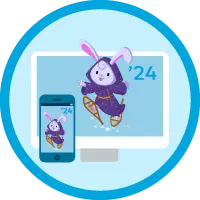Platform Developer I Certification Maintenance (Winter '24)
→ Maintain Your Platform Developer I Certification for Winter '24
1. Which SOQL keywords can be used to respect the object permissions of the running user for a query in Apex code?
A. WITH USER_MODE
B. WITH SYSTEM_MODE
C. Insert as user
D. Insert as system
2. Where can an error message be displayed by adding the Custom Error Message element to a flow?
A. In a window on the record page
B. As an inline error on a specific field
C. Either A or B
D. Neither A or B
3. Why are the lwc:if, lwc:elseif, and lwc:else conditional directives more efficient than the legacy if:true and if:else directives?
A. Property getters are accessed only once per instance of the directive.
B. No property getters are accessed.
C. The new directives are not more efficient than the legacy directives.
D. Property getters are accessed multiple times.
4. Which of the following can be used to iterate through lists or sets in a for loop?
A. Iterable string
B. Loop construct
C. Iterable variable
D. Index variable
5. Which Apex feature can be used to customize the behavior of the List.sort() method?
A. CustomSort class
B. Comparator interface
C. CustomSort interface
D. Sets
→ Get Hands-on with Bind Variables in a SOQL Query
Launch the org you’ll use for the hands-on challenge, then do the following prework.Step: 1
Now, as mentioned in trailhead challenge, we need to create one apex class.
Follow below steps in developer console To open the Developer Console from Salesforce Classic:
- Click Your Name.
- Click Developer Console.
To open the Developer Console from Lightning Experience:
- Click the quick access menu (
 ).
). - Click Developer Console.
~ File > New > Apex Class
Step: 2
As mentioned in trailhead challenge, enter 'Apex Class' name and click 'OK' button.
Class Name: QueryContact
Class Name: QueryContact
Copy below mentioned code and paste in developer console and 'Save' this apex class.
Certification Maintenance Due Date: December 6, 2024
Helpful link:
Winter '24 Certification Maintenance




Thanks Nikhil
ReplyDeleteThank you Nikhil
ReplyDeleteThank you Nikhil
ReplyDeleteThank you Nikhil for sharing the code.
ReplyDeleteThanks Nikhil
ReplyDeleteThank you Nikhil for sharing!
ReplyDeleteThank you Nikhil for sharing!
ReplyDeleteThank you
ReplyDeleteThank you so much!
ReplyDeleteThank you nikhil.
ReplyDeleteThank you so much Nikhil
ReplyDeleteありがとうニキル
ReplyDeleteSalesforce Help: Dynamically Pass Bind Variables to a SOQL Query:
ReplyDeletehttps://help.salesforce.com/s/articleView?id=release-notes.rn_apex_bind_var_soql.htm&release=242&type=5
Apex Reference Guide: Database Methods:
ReplyDeletehttps://developer.salesforce.com/docs/atlas.en-us.apexref.meta/apexref/apex_methods_system_database.htm?&_ga=2.97654175.1633002055.1706889881-1749918853.1706889881#apex_System_Database_methods
Thanks
ReplyDeleteThanks
ReplyDeleteThank you for sharing the code, Nikhil.
ReplyDeleteThanks Nikhil!
ReplyDeleteThank you Nikhil
ReplyDeleteThank you Nikhil
ReplyDeleteThank you Nikhil for sharing code.
ReplyDeleteThanks Nikhil 😊😄
ReplyDeleteThank you Nikhil.
ReplyDeleteThanks man!
ReplyDeleteThnaks Nikhil
ReplyDeleteThank you Nikhil.
ReplyDeleteThanks
ReplyDeleteThank you for the assist!
ReplyDeleteThank you, Nikhil, for sharing!
ReplyDeleteThanks for the help Nikhil
ReplyDeleteThank you Nikhil.
ReplyDelete